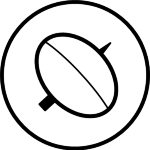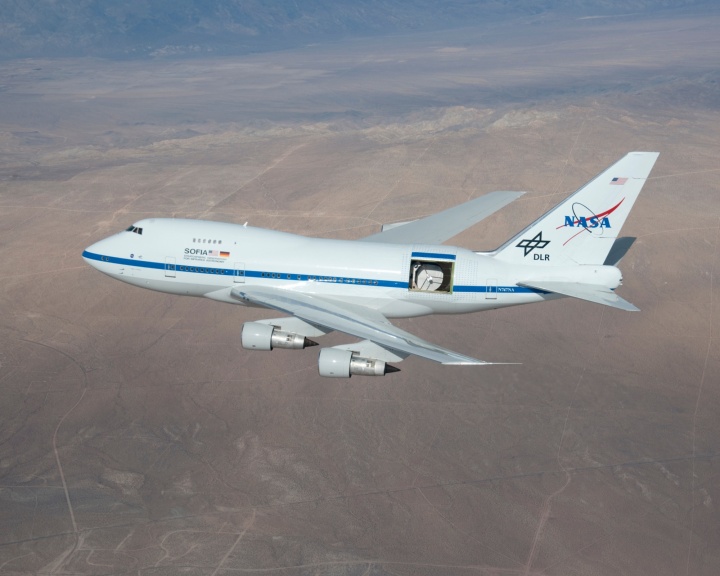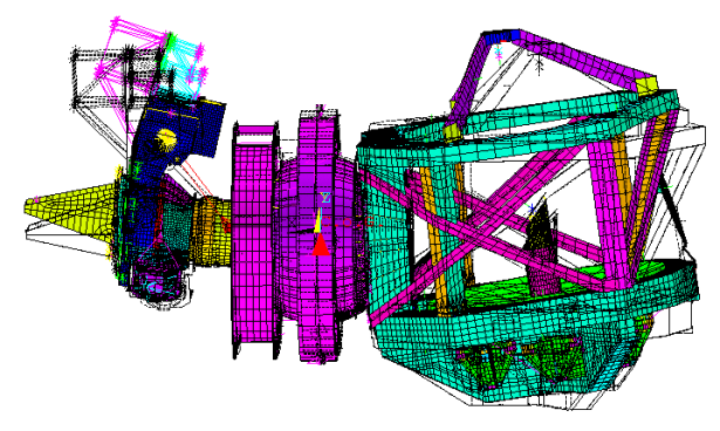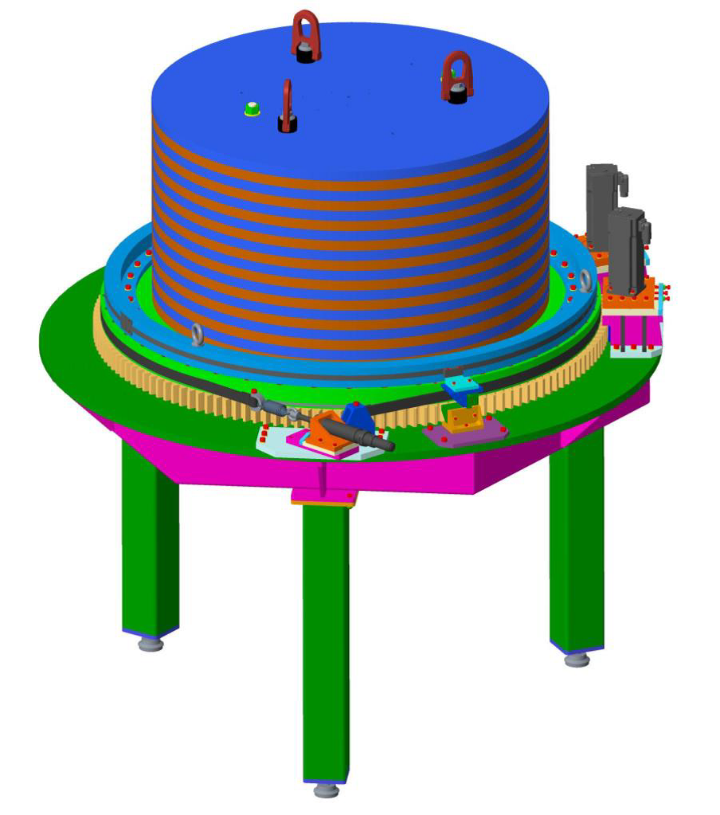Projects
The research on astronomical instruments takes place in cooperation with the German SOFIA Institute (DSI), University of Stuttgart, and the Max-Planck-Institue for Astronomy (MPIA), Heidelberg.
The Stratospheric Observatory For Infrared Astronomy (SOFIA) was a unique, flying observatory for exploring the universe in the infrared wavelength range. The central part of the observatory was a mirror telescope with a 2.7 m main mirror placed in an open bay of a converted Boeing 747SP. From an altitude of 12 to 14 kilometers, the observatory provided insights into the formation of stars and solar systems, largely isolated from atmospheric disturbances, which impede observations from the ground in the infrared part of the electromagnetic spectrum.
SOFIA is currently in the follow-up phase. It is still a joint project of the German Aerospace Center e.V. (DLR) and the National Aeronautics and Space Administration (NASA). The German part is carried out on behalf of the DLR with funding from the Federal Government (BMWi), the State of Baden-Württemberg and the University of Stuttgart. The German SOFIA Institute (DSI) of the University of Stuttgart coordinates especially the scientific operation on the German side under the BMWi grant 50OK0901, on the American side the operation is carried out by the NASA Ames Research Center (ARC) and the Universities Space Research Association (USRA). The entire project is 80% funded by NASA and 20% by DLR; this concerns both the construction of the observatory and the current 20-year operation.
The Chair is involved in technical questions of SOFIA, which mainly concern the telescope. Here, the movement detection of the telescope is of particular importance, since the optical system had to be kept as quiet as possible during the observation operation. Main focal points here are:
- Fiber optical gyro measurement unit for inertial stabilization of the telescope:
calibration, modeling, and data processing, - high-quality motion measurement of the telescope structure by means of data fusion.
References:
- Temi, P. et al.: SOFIA at Full Operation Capability: Technical Performance. In: Journal of Astronomical Instrumentation 7 (2018), Nr. 4 S. 1840011.1 - 1840011.24
- Kaswekar, P.; Wagner, J.: Sensor fusion based vibration estimation using inertial sensors for a complex lightweight structure. In: Trommer, G. (Hrsg.): Proc. of the 2015 DGON Inertial Sensors and Systems. Karlsruhe: IEEE, 2015, S. 10.1-10.20
Abstract - Wagner, J.; Kärcher, H.; Britz, A.: Die Sternwarte SOFIA. In: mobiles 38 (2015), S. 56-62
Abstract - Kärcher, H.J.: SOFIA, das stratosphärische Observatorium. Wie konstruiert man ein Flugzeugteleskop? Sterne und Weltraum 50 (2011), Nr. 7, S. 42-52
- Harms, F. et al.: Performance Evaluation of the Fiber Optic Gyroscopes Integrated into the SOFIA Telescope Assembly. In: Trommer, G. (Hrsg.): Proc. of the Symposium Gyro Technology. Karlsruhe: Universität Karlsruhe / Deutsche Gesellschaft für Ortung und Navigation, 2009, S. 11.1-11.19
Abstract - Titz, R.; Röser, H.-P.: SOFIA – Astronomie und Technologie im 21. Jahrhundert. Berlin: Wissenschaft und Technik Verlag, 1998
A second field of work for SOFIA is modeling the structural mechanics of the telescope. Since this precision instrument was subject to repeated modifications during its service life of more than 8 years, the associated changes in dynamic properties had to be reliably predicted and analyzed. For this purpose, there is a detailed Finite Element model, which, in accordance with its use, was repeatedly expanded and compared with measurement data generated during operation. Focal points here were:
- modeling, identification and optimization of the secondary mirror unit,
- modeling, identification and motion simulation of the telescope structure.
References:
- Lammen, Y. et al.: Increasing the SOFIA Secondary Mirror Mechanism's Fast Steering Capability by Identification of a Structural Resonance and its Subsequent Elimination Through Mass Redistribution. In: Journal of Astronomical Instrumentation 7 (2018), Nr. 4, S. 1840001.1 – 1840001.11
Download - Greiner, B. et al.: A New Finite Element Model of the SOFIA Primary Mirror Cell to Investigate Dynamical Behavior. In: Marshall, H.; Spyromilio, J.; Gilmozzi, R. (Hrsg.): Ground-based and Airborne Telescopes VII, Proc. of SPIE. Vol. 10700. Bellingham, WA: SPIE, 2018, S. 107000K.1-107000K.10
Abstract - Keas, P. et al.: SOFIA Telescope Modal Survey Test and Test-Model Correlation. In: Angeli, G.; Dierickx, P. (Hrsg.): Modeling, Systems Engineering, and Project Management for Astronomy IV, Proc. of SPIE. Vol. 7738. Bellingham, WA: SPIE, 2010, S. 77380K.1- 77380K.26
Abstract
The Multi-Adaptive Optics Imaging CAmera for Deep Observation (MICADO) is one of the first light instruments for the Extremely Large Telescope (ELT), primary mirror diameter 39 m, in combination with the Multi-Conjugate Adaptive Optics Relay (MAORY). The MICADO consortium started the preliminary design phase for the instrument in October 2015.
Due to the azimuthal mount of the ELT, it is necessary to rotate the field of view of the instrument around the line of sight for the longer observation times being typical for faint objects. This is done by a so-called derotator. For the current concept of MICADO - a cryostat, which carries the main optics and the cold detector array - the derotator should be mounted between the central ring flange of the cryostat and the instrument support structure.
In the past years, the Chair has been involved in the following questions:
- Selection of a suitable concept for the mechanical design of the derotator from technically feasible possibilities.
- Static and dynamic analysis and optimization of the mechanical structure of the derotator.
- Design of a multi-body model for the simulative proof that the requirements can be met with the designed layout of the derotator.
- Testing of the simulation method by comparison of simulated and experimental data, namely on the basis of a test stand with a scaled down, modeled version of the derotator.
The work was funded by the DAAD.
References:
- Barboza, S.: Design and prototyping of the image derotator for the ELT infrared instrument MICADO. Universität Stuttgart, Diss., 2018
Download - Barboza, S. et al.: Design of a large image derotator for the E-ELT instrument MICADO. In: Evans, C.; Simard, L.; Takami, H. (Hrsg.): Ground-based and Airborne Instrumentation for Astronomy VI, Proc. of SPIE. Vol. 9908. Bellingham, WA: SPIE, 2016, S. 99089H.1-99089H.14
Abstract
Contact





